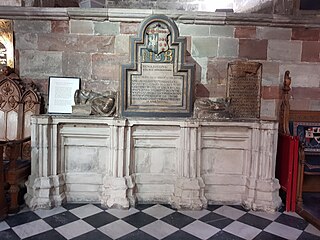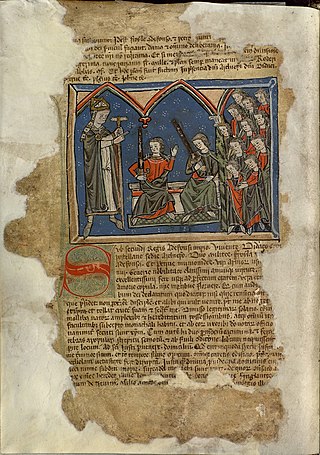Pope Gregory VI, born Giovanni Graziano in Rome, was bishop of Rome and ruler of the Papal States from 1 May 1045 until his resignation at the Council of Sutri on 20 December 1046.

David John Conner, is a British Anglican bishop. He served as Dean of Windsor from 1998 to 2023, and was additionally the Bishop to the Forces between 2001 and 2009. He previously served as Bishop of Lynn, a suffragan bishop of the Diocese of Norwich, from 1994 to 1998, and in school chaplaincy. Conner retired effective 31 July 2023.

Nicholas Bullingham was an English cleric who became the Bishop of Lincoln and Bishop of Worcester.

Thomas Smith (1615–1702) was an English clergyman, who served as Dean of Carlisle, 1672–1684, and Bishop of Carlisle, 1684–1702. He graduated MA from The Queen's College, Oxford in 1639 and served as chaplain to King Charles II.

Diego Gelmírez or Xelmírez was the second bishop and first archbishop of the Catholic Archdiocese of Santiago de Compostela in Galicia, modern Spain. He is a prominent figure in the history of Galicia and an important historiographer of the Iberia of his day. Diego involved himself in many quarrels, ecclesiastical and secular, which were recounted in the Historia Compostelana, which covered his episcopacy from 1100 to 1139 and serves as a sort of gesta of the bishop's life.
Richard the Chaplain was the Chaplain of King Máel Coluim IV before becoming Bishop of Cell Rígmonaid, the highest ranking Scottish see of the period. He came from a well connected Anglo-Norman Lothian-based family, and was the nephew of Alwin, Abbot of Holyrood. Richard was elected to the see in 1163, soon after the death of his predecessor Ernald, and was consecrated on Palm Sunday 1165 by other Scottish bishops in the presence of the king. He died in 1178 in the infirmary of the canons of the church. He was succeeded by John, called "l'Escot".
Hugh the Chaplain was the royal Chaplain of King William I of Scotland before becoming Bishop of Cell Rígmonaid (St Andrews), the highest ranking Scottish see of the period. After the death of Bishop Richard, King William selected Hugh to succeed to the bishopric in 1178. However, unbeknown to the king, the chapter elected their archdeacon, John l'Escot, as bishop. The king saw to Hugh's election and consecration in the same year. There followed a five-year struggle for the bishopric. John travelled to appeal to Pope Alexander III, who quashed the case of Hugh and sent to Scotland a man named Alexius as legate. Alexius obtained entrance to William's kingdom, and consecrated John at Holyrood Abbey in the presence of four other Scottish bishops, in the year 1180. Nevertheless, the struggle continued, and in 1183, both John and Hugh resigned their rights. Despite the fact that Hugh received the bishopric and John took the Bishopric of Dunkeld in compensation, dispute over revenues continued. When Hugh refused to answer his summons to Rome in 1186, he was suspended and excommunicated, with the diocese being put under interdict. Hugh travelled to Rome and obtained absolution, but he died of the pestilence in that city a few days later.
Walter Capellanus was an important cleric and politician in the Kingdom of Scotland during the reigns of kings William the Lion and Alexander II.
Richard was a 12th-century bishop of Dunkeld. He got the bishopric of Dunkeld, the second most prestigious bishopric in Scotland-north-of-the-Forth, after serving the King of Scots. He was capellanus Regis Willelmi, that is, chaplain of King William I of Scotland, and had probably been the chaplain to William during the reign of King Malcolm IV. He was consecrated at St Andrews on 10 August 1170, by Richard, former chaplain of King Malcolm IV but now the bishop of St Andrews. Richard continued to have a close relationship with King William I, and was in Normandy with the king in December 1174 when the Treaty of Falaise was signed.
Theulf was a medieval Bishop of Worcester.
Robert Capellanus, was a chaplain of King William I of Scotland and afterwards, Bishop of Ross (1214–1249).
Charles Hickman, an Anglican divine in the Church of Ireland, was Bishop of Derry from 1703 to 1713.
Colin William Fletcher is a British retired Anglican bishop. He served as area Bishop of Dorchester in the Diocese of Oxford.

Pelagiusof Oviedo was a medieval ecclesiastic, historian, and forger who served the Diocese of Oviedo as an auxiliary bishop from 1098 and as bishop from 1102 until his deposition in 1130 and again from 1142 to 1143. He was an active and independent-minded prelate, who zealously defended the privileges and prestige of his diocese. During his episcopal tenure he oversaw the most productive scriptorium in Spain, which produced the vast Corpus Pelagianum, to which Pelagius contributed his own Chronicon regum Legionensium. His work as a historian is generally reliable, but for the forged, interpolated, and otherwise skilfully altered documents that emanated from his office he has been called el Fabulador and the "prince of falsifiers". It has been suggested that a monument be built in his honour in Oviedo.

Pedro Fróilaz de Traba was the most powerful secular magnate in the Kingdom of Galicia during the first quarter of the twelfth century. According to the Historia compostelana, he was "spirited ... warlike ... of great power ... a man who feared God and hated iniquity," for Diego Gelmírez himself had "fed him, like a spiritual son, with the nutriment of holy teaching." Brought up at the court of the Emperor Alfonso VI, Pedro raised the future Emperor Alfonso VII in his household. Around the latter he and Diego formed a "Galician party" that dominated that region during the turbulent reign of Urraca (1109–26). In September 1111 they even had the child Alfonso crowned king at Santiago de Compostela, but it was Pedro who was imperator in orbe Galletiae.

Rodrigo Vélaz was the "count of Galicia, who held Sarria" according to the near-contemporary Chronica Adefonsi imperatoris. During his long public career he was the dominant figure in mountainous eastern Galicia while the House of Traba dominated its western seaboard. He served under three monarchs—Alfonso VI, Urraca, and Alfonso VII—and was loyal to all of them, never figuring in any rebellion. The contemporary Historia compostellana is a valuable source for his life, since there are no aristocratic archives surviving in Spain from this period. Rodrigo's career must be pieced together from the few references in the chronicles and the charters preserved in various ecclesiastical archives.

Suero Vermúdez was an Asturian nobleman, territorial governor, and military leader. His career was marked by loyalty to the crown of León-Castile during the reigns of Alfonso VI, Urraca, and Alfonso VII. He never took part in any revolt, but fought in many wars against rebels, against rivals, and against the Moors.
Diego was the Bishop of León from 1112 or 1113 until his deposition in 1130. He succeeded his uncle Pedro, whose episcopate, and life, had ended in exile after the Battle of Candespina (1111). After a brief usurpation by Archbishop Maurice of Braga, Diego was elected to replace Pedro.
Anthony Peter Bishop, CB, QHC, FRSA is a British Anglican priest and retired military chaplain. In 1995 to 1998 he was appointed Resident Chaplain of St Clement Danes in London, the central church of the Royal Air Force. From 1998 to 2001, he served as Chaplain-in-Chief, and thereby head of the Royal Air Force Chaplains Branch, and Archdeacon for the Royal Air Force.
Baldrick II was bishop of Liège from 1008 to his death at Heerewaarden in what is now the Netherlands.






